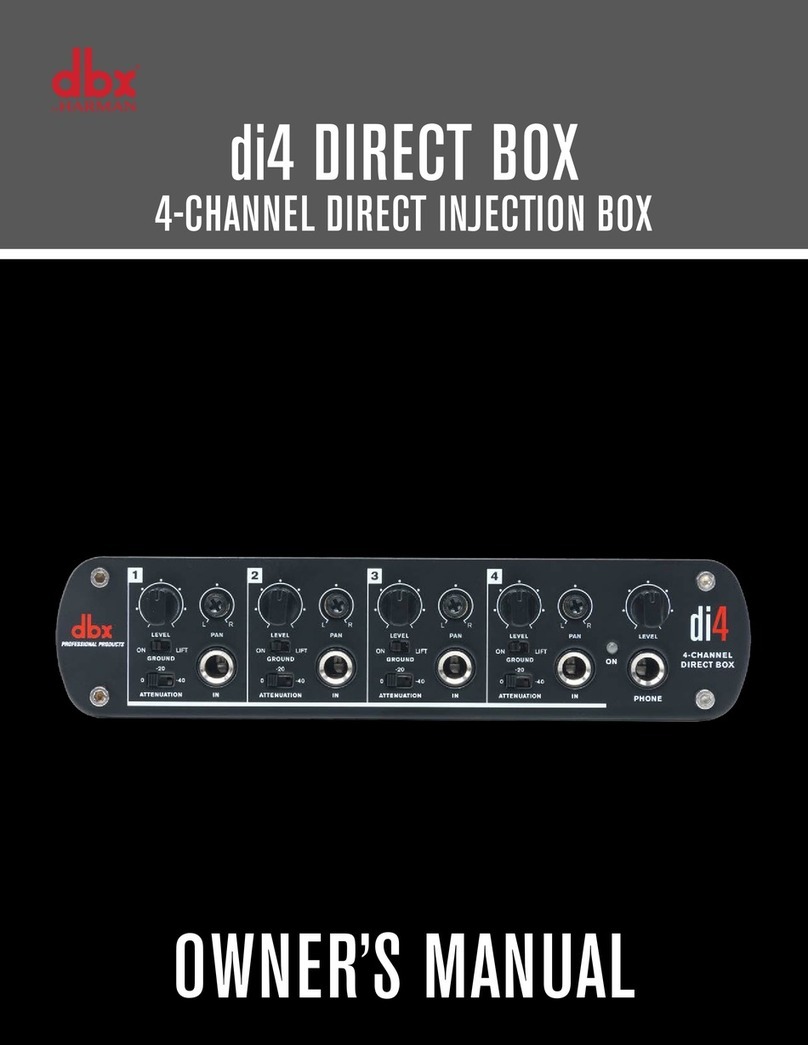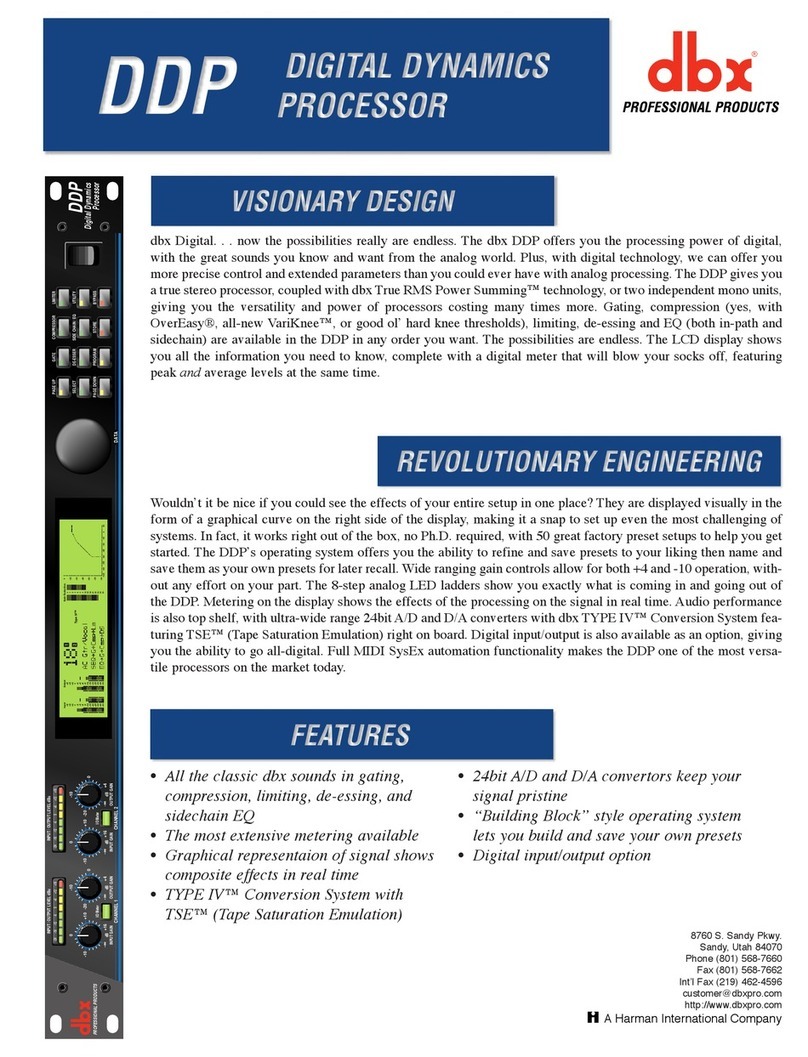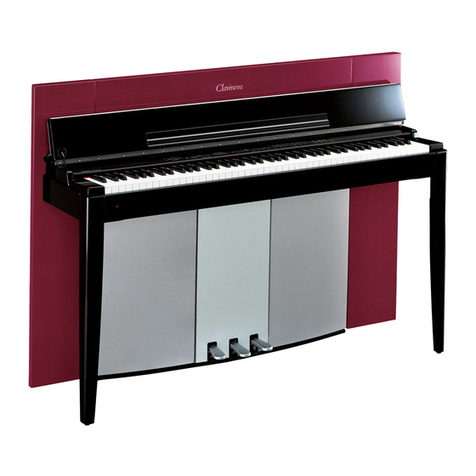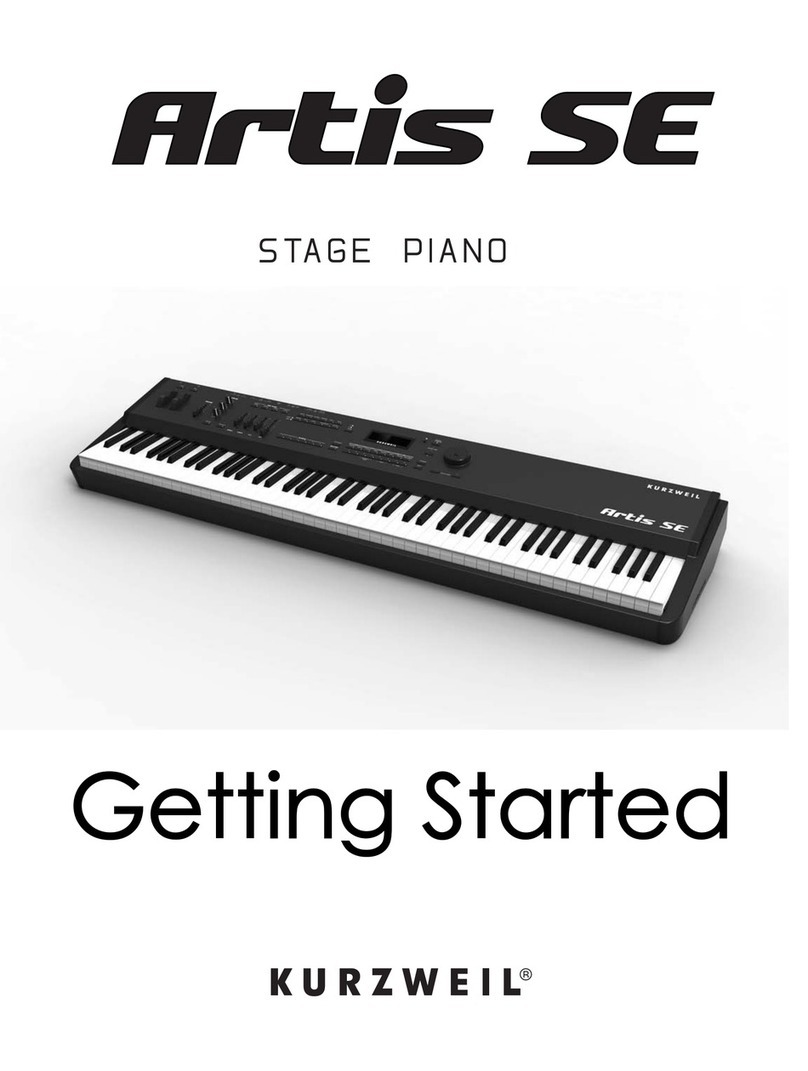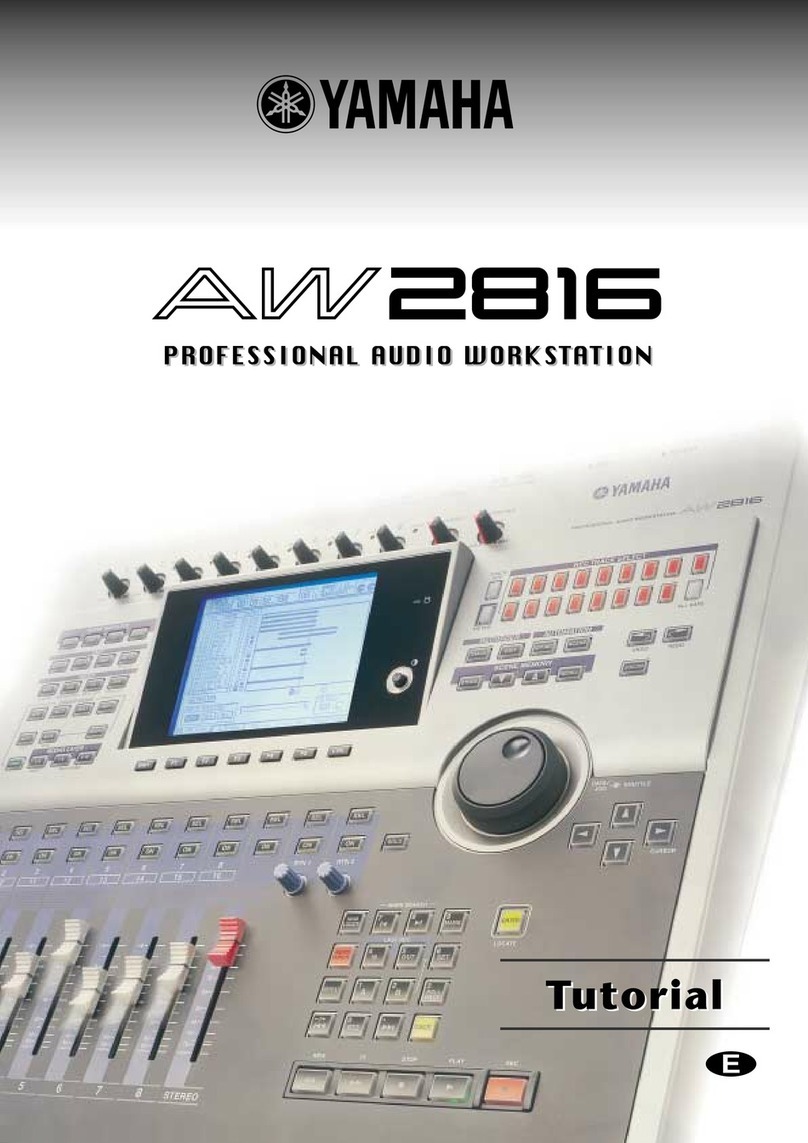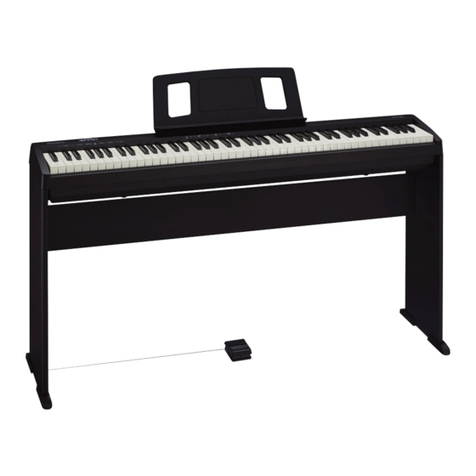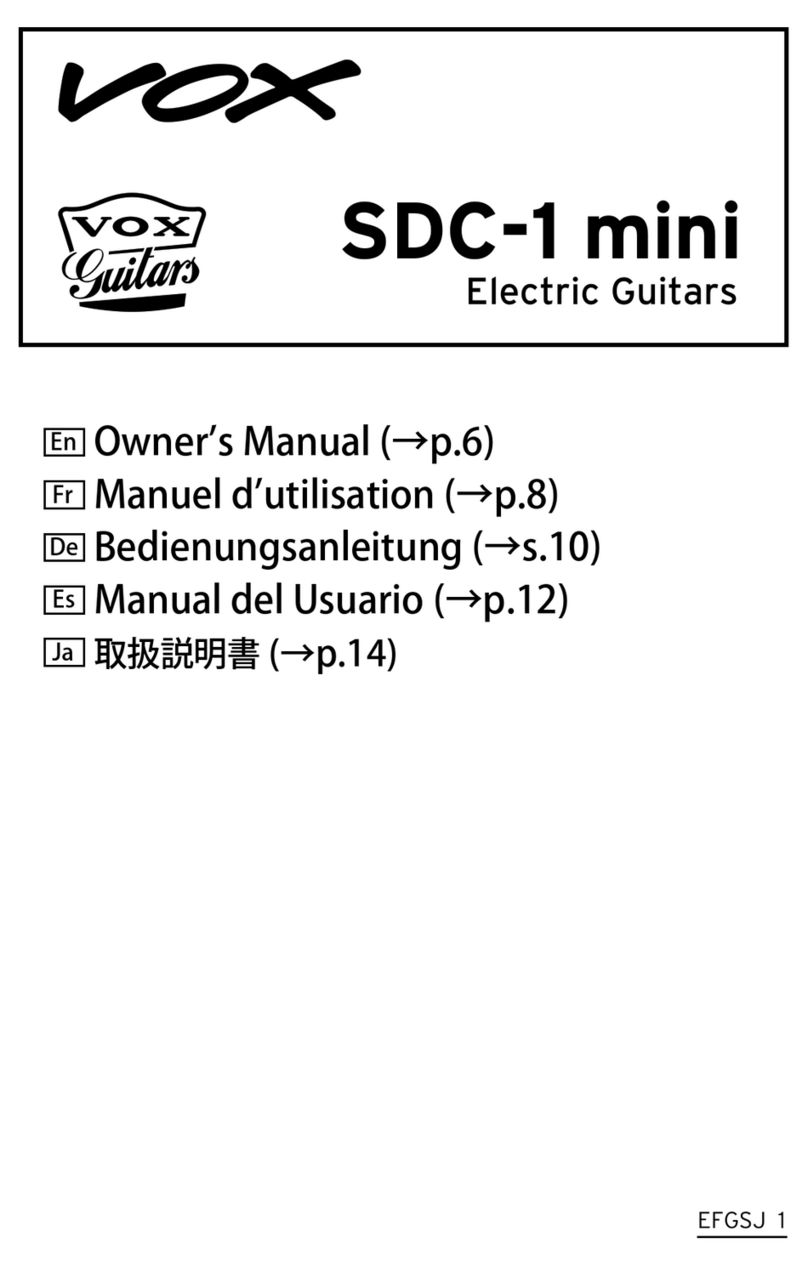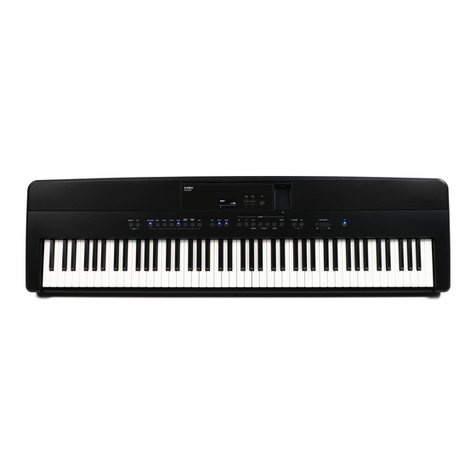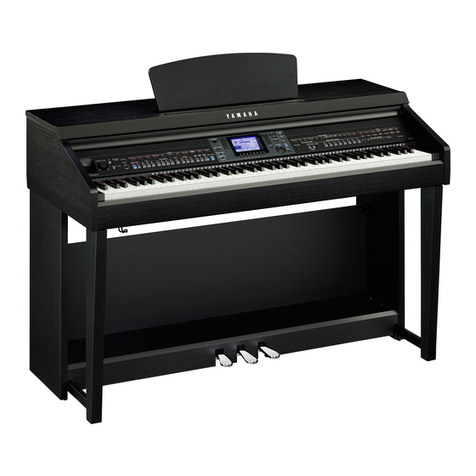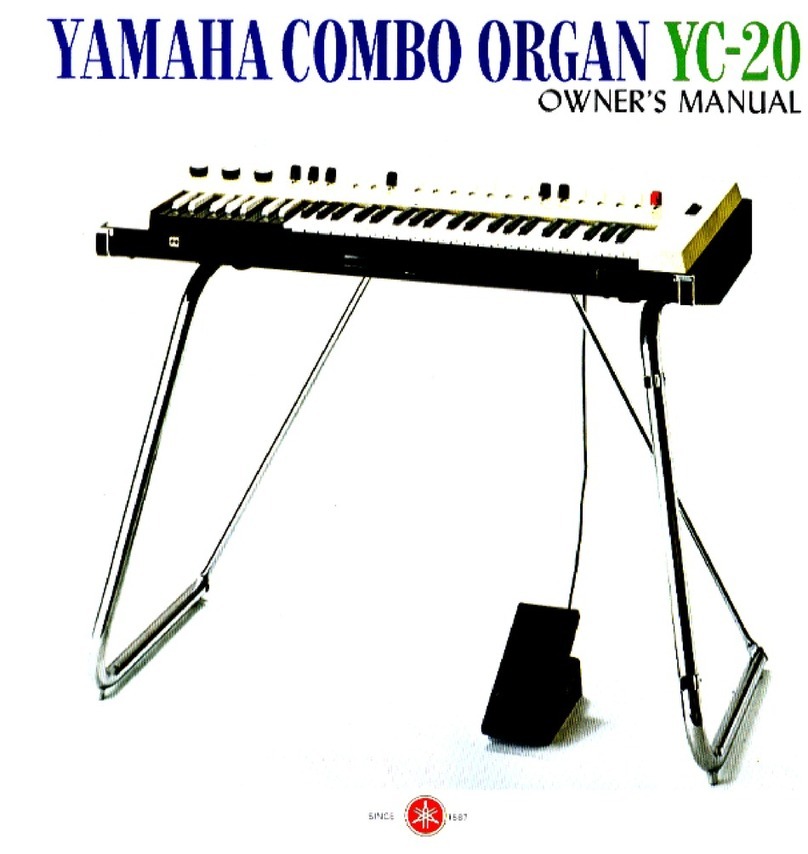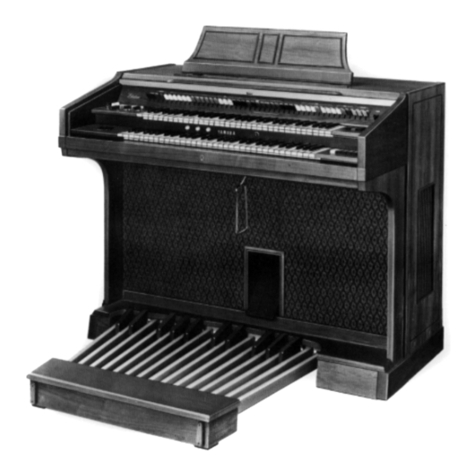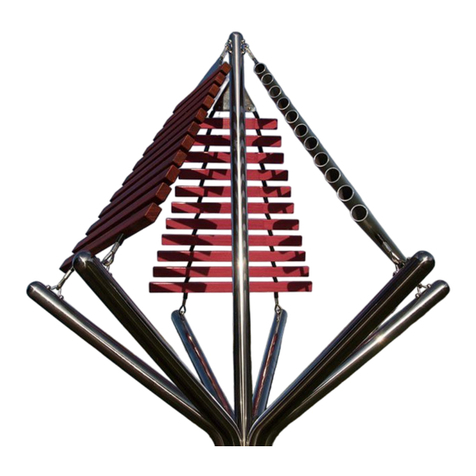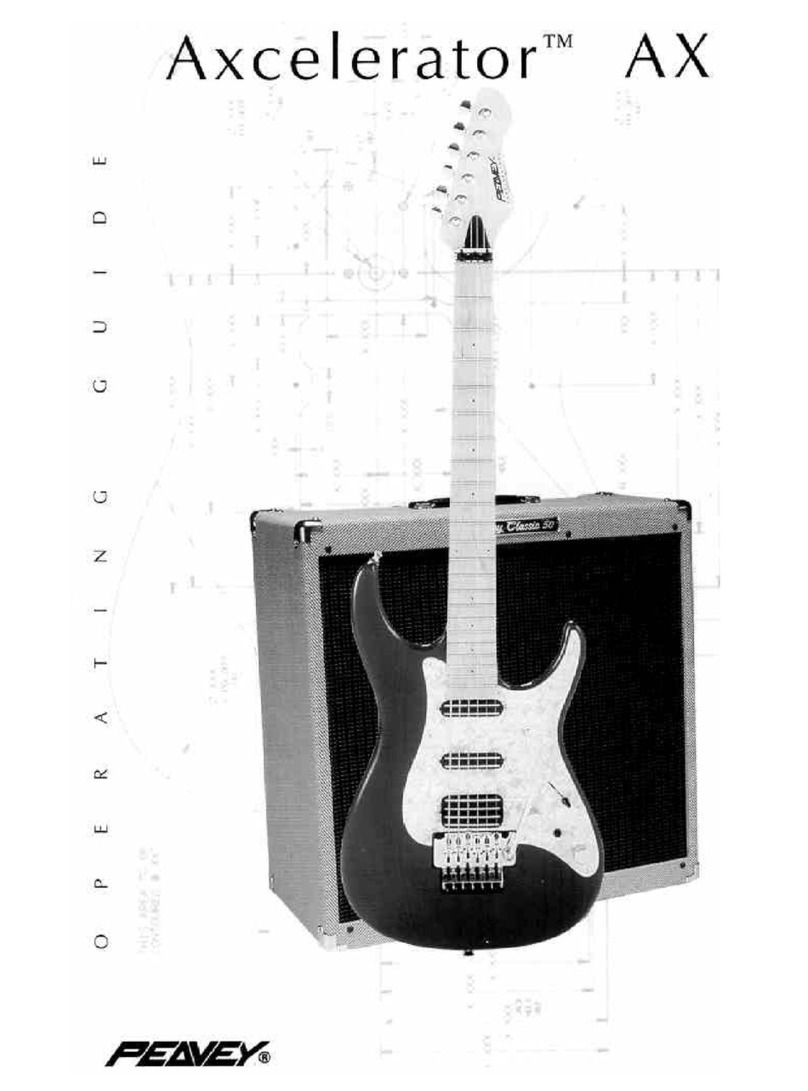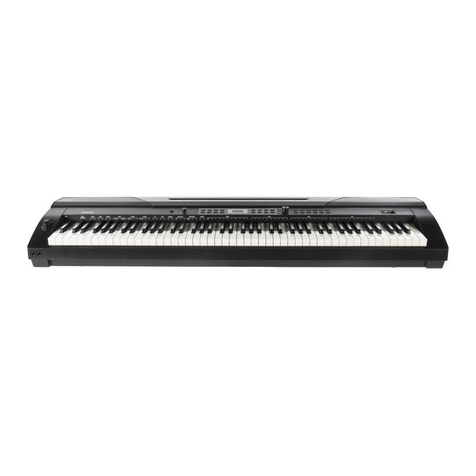dbx 363X User manual

MODEL 363X
aINoise Gate
Service Manual
(Preliminary)

CAUTION |AVIS |
RISK OF ELECTRIC SHOCK
DO NOT OPEN
RISQUE OE CHOC
ELECTRIQUE
NE PAS OUVRIR
DO NOT EXPOSE TO RAIN OR MOISTURE
CAUTION: TO REDUCE THE risk of electrical shock, do NOT REMOVE COVER (OR BACK).
NO USER SERVICEABLE PARTS INSIDE. REFER SERVICING TO QUALIFIED SERVICE PERSONNEL
WARNING: TO REDUCE THE RISK OF FIRE OR ELECTRICAL SHOCK, DO NOT EXPOSE THIS APPLIANCE TO
RAIN OR MOISTURE.
This symbol, wherever it appears,
alerts you to the presence of uninsulated
dangerous voltage inside the enclosure —voltage
that may be sufficient to constitute arisk of shock.
This symbol, wherever it appears,
alerts you to important operating
and maintenance instructions in
the accompanying literature.
Read the manual.
Manufactured under one or more of the following U.S. patents: 3,377,792; 3,681,618; 3,714,462; 3,789,143;
4,097,767; 4,329,598; 4,403,199; 4,409,500; 4,425,551; 4,473,795. Other patents pending.
This dbx-branded product has been manufactured by AKG Acoustics, Inc.
AKG is aregistered trademark of Akustiche u. Kino-Gerate Ges m.b.H., Austria.
All trademarks are property of their respective companies.
This manual is part number 96015-000-02
©Copyright 1993 by AKG Acoustics, Inc. 75 -FB -1/93
Jbx
dbx Professional Products
adivision of AKG Acoustics, Inc.
1525 Alvarado Street, San Leandro, CA 94577 USA
Telephone (1) 510/351-3500 Fax: (1) 510/351-0500

Introduction
The half rack design of the 363X can accommo-
date up to four channels of gating in one rack
space, or 16 channels of gating in four rack spaces.
The 363X can be auseful tool in any musical
situation.
In the studio, the 363X can be used to:
•Eliminate headphone leakage into the mi-
crophones
•Gating drum mics to eliminate rattling
snares or to tighten the sound of akick
drum
•Gating instrument mics to eliminate amp
noise
•Muting the mixdown inputs to the two-
track as an economical solution to automat-
ion
In live sound applications, the 363X can be used
to gate:
•signal processing gear that produce hum
such as synthesizers, samplers and elec-
tronic drums
•Microphones for lead vocals, background
vocals, drums and other musical instru-
ments
•Microphones that are intermittently used
•Noisy digital and analog reverb and delay
devices
Special Applications
The 363X gating action can be controlled by an
external signal at the Key Input on the rear panel.
This is useful for applications such as frequency
weighted gating or anticipatory gating for zero at-
tack times.

Front Pandl dbx 363X
Figure 1: Front Panel
A. STEREO COUPLE switch and LED.
Depress this switch to activate Stereo-coupling
(CH 1MASTER, CH 2SLAVE). The LED next
to the STEREO COUPLE button turns on when
the 363X is actively stereo coupled. In Stereo
Couple mode, the THRESHOLD, HOLD and
RELEASE controls on Channel 2have no effect
on the gating action. The Channel 2OPEN,
HOLD and RELEASE LEDs track with Channel
1meters.
B. THRESHOLD control and OPEN LED
(CH 1and CH 2)
Adjusting this control sets the level at which
the gate will open with regard to the Input
level. The THRESHOLD control is calibrated in
dB from -60 to +20dB, to provide an 80dB oper-
ating range.
The green OPEN LED located above the
THRESHOLD control turns on whenever the in-
put signal (or Key Input signal) rises above the
set THRESHOLD level.

Front Panel
Figure 2: Front Panel
CHOLD control Lnd HOLD LED
(CH 1and CH 2)
The Hold function determines the amount of
time the gate remains open after the input sig-
nal falls below the threshold. The HOLD con-
trol is calibrated in seconds, with arange of 0
(OFF) to 3seconds.
When the HOLD function is used, the yellow
HOLD LED turns on as soon as the input level
falls below the threshold. The HOLD LED will
remain illuminated until the HOLD function
has completely timed out.
4

Front Panel dbx 363X
D. RELEASE control and RELEASE LED
(CH 1and CH 2)
The RELEASE control determines the rate at
which the gate closes once the signal at [the in-
put falls below the threshold and the HOLD
function is timed out.
The RELEASE control is calibrated from 3000 1
dB/second to 10 dB/second. :
The intensity of the red RELEASE LED will in-
crease as the attenuation increases. If the Re-
lease rate is set for afast release, the LED
illuminates quickly.
E. KEY MONITOR switch (CH 1and CH 2)
Depressing this switch allows the signal at the
KEY input to be routed directly to the audio
output. When KEY MONITOR is selected, all of
the front panel functions are inactive except BY-
PASS. i
F. KEY ENGAGE switch (CH 1and CH 2)
Depressing this switch causes the channel to re-
spond to the signal at the KEY input. When the
Key Engage switch is depressed and no signal
is present, the 363X does not pass ajny signal.
G. BYPASS switch (CHI and CH 2)
Depressing the BYPASS button creates a"hard-
wire bypass" of the 363X circuitry Ipy connect-
ing the input directly to the output!1
BYPASS overrides all controls, even if power is
removed from the 363X.
5

Rear Panel
Figure 3: Rear Panel
A. INPUT Connector (CHI and CH 2)
The signal input of the 363X is unbalanced and
can accept amaximum input level of +18dBu.
It requires aWHp/Sleeve phone plug.
B. OUTPUT Connector (CH 1and CH 2)
The signal output of the 363X is unbalanced
and is capable of driving +18dBu into a6000
load. It requires aWTip/Sleeve phone plug.
C. KEY Input (CHI and CH 2)
The KEY input is unbalanced and can accept a
maximum input level of +20dBu. It requires a
WTip/Sleeve phone plug.
D. AC Voltage Select Switch
Selects for use between 120VAC or 240VAC op-
eration. Be sure to determine the line voltage
before applying power to the 363X.

Rear Panel
E. AC power cable
Connect this cable to any 50Hz or 60Hz AC
power source of the correct line voltage, as
shown by the AC LINE VOLTAGE requirement
indicator above. Note that the 363X does not
have apower switch. It is recommended that
the363X be "ON" at all times. The Model 363X
consumes amaximum of 12 watts AC power.
WARNING: Be sure to verify both your actual
line voltage and the voltage for which your
Model 363X was wired, as indicated on the rear
panel of your unit. Connection to an inappro-
priate power source may result in extensive
damage which is not covered by the warranty.
dbx 363X
7

Connecting The 363X To Your System
The 363X can be used with any line-level device.
Some common examples include: mixing consoles,
musical instruments, patch bays, and signal proces-
sors.
A. Mixing Board:
If you wish to gate aparticular track of amulti-
track recording or one channel of alive per-
formance mix, the 363X output can be directly
connected to aline input jack, or wired to an In-
sert point.
8

Connecting The 363X To Your System dbx 363X
Figure 5: Connecting a363X to aGuitar
B. Musical Instruments (i.e., Electric Guitar,
Bass, Keyboards):
Because the 363X has an 80dB input range, the
output of an electric guitar can drive the 363X's
input. For greater sensitivity and improved sig-
nal to noise, it is recommended that the 363X be
connected to the "PREAMP OUT" of your gui-
tar amp (if so equipped), or the output of some
other device that is designed to accept low-
level instrument inputs (including various
stomp boxes, rack mount audio products, and
the dbx Performer Series processing units). Fig-
ure 5A shows the 363X connected between the
output of apre-amp and the input of apower
amp.
Microphones, like guitars, also typically have
low-level outputs. Therefore, it is recom-
mended that the 363X be connected after the
mic pre-amp.
In Figure 5B, the 363X is connected to the out-
puts of asynthesizer to gate out the constant
noise inherent in most keyboards. 9

Connecting The 363X To Your System
Figure 6: Connecting the 363X for Sound Reinforcement
C. Sound reinforcement:
Placing the 363X in series with the main mix
output is acost effect means of eliminating
hum and buzz from the house speakers. Simply
set the threshold level low enough to allow the
gate to open at the presence of asignal, but
high enough to gate out the noise.

The 363X can be used in avariety of ways in
live sound reinforcement. In Figure 7A, the
363X is being used to gate the vocal mike on
and off in the floor monitors. This is an excel-
lent means of suppressing feedback into the
monitors when the microphone is not being
used. Normally feedback is not aproblem into
the house speakers, however there are in-
stances when these cabinets are placed on the
stage just in front of the band. The 363X can
provide controlled isolation when mics located
close to these speakers are open. Figure 7B
shows the typical connection.

Connecting The 363X To Your System
Studio Applications
Figure 8: Multi Channel Connections
The 363X can be set for 2-channel stereo opera-
tion by pressing the STEREO COUPLE button.
This will force Channel 2(SLAVE) to track
Channel 1(MASTER) to preserve proper stereo
imaging.
Channel 1controls will adjust the amount and
nature of the gating and Channel 2will track ac-
curately.
In Figure 8the 363X is switched to the stereo
couple mode and inserted into the signal path
between the mix outputs of the console and the
inputs of the 2-track mixdown machine. The
threshold of the 363X is set low enough to gate
out the hiss from the multi-track but open at
the presence of asignal. This is an effective
means of achieving automation muting with
consoles not equipped with this feature.
The 363Xs two channels operate completely in-
dependently when the STEREO COUPLE but-
ton is not depressed.

Special Connections (OPTIONAL) dbx 363X
Using The Key Input
|
iarv^e^c^^ouhwf^fh*^S^Y^f^pS
v,
T^e^ft"]** ®u.
di°inPu»<via an auxiliary device), connect the auxil-
fJ7. ,to.t
J*e363*sKEY Iryut Jack'and feed the auxiliary device's input with the same signal
tS SlYTh3X Slr"anp
!J
t‘nP,gUre 9'an e<lualizer inPut is connected in parallel with the signal input of
™fi^3
»h‘ Th Badjusted to accentuate the frequencies that will control the gating action. The
Pout-
put of the equalizer is then fed to the Key Input of the 363X. When the microphone receives audio the 363X
wiU open and pass the signal through to the output of the 363X at unity gaining the 363X in thisconfieu-
rahon will eliminate false triggering from other nearby sound sources.
'.I-
NOTE: You could substitute aguitar or other instrument for the snare.
Equalizer
Input -Equalizer
Output
Audio
Input
Key
Input ,,
:1
Multi
Track
Recorder
363X Audio
Output
Figure 9: Using the 363X Key Input

Basic Operation (Control Descriptions)
Figure 10: Front Panel
14

Basic Operation (Control Descriptions) dbx 363X
!
!
A. THRESHOLD control:
The Threshold control sets the level at Which
the gate will open and allow the signal iat the in-
put to pass through to the output. The 363X has
an 80dB threshold range which will allow it to
be used with avariety of low level and line de-
vices. Turn the THRESHOLD control com-
pletely clockwise. Set the HOLD control to the
OFF position and set the RELEASE control
around lOOOdB/S. Apply the signal to be gated
to the input of the 363X and adjust the 1
THRESHOLD control counter-clockwise until
the signal can be heard at the output. The
THRESHOLD control should be set so the gate
opens every time the signal is applied. If the dy-
namics of the instrument being gated changes
dramatically in the context of the perfonnance,
it may be necessary to re-adjust the THRESH-
OLD to allow the softer signals to open the gate.
B. OPEN LED ;
The green LED labelled "OPEN" illuminates
when the signal has crossed over the set thresh-
old level and quickly extinguishes when the sig-
nal falls under the threshold. This LED can also
serve as a signal present indicator when
trouble-shooting through your system.
C. HOLD control
IThe Hold control is used to reduce false trigger-
ing and to allow for acertain amount of decay
time inherent to some types of musical instru-
ments. The hold circuit begins its timing proc-
ess once the signal falls under the threshold
.
The 363X provides up to amaximum of 3sec-
onds of hold time. An example of when the
hold function would be utilized would be to al-
low apiano of guitar to fade naturally without
truncating the signal. Or another use would be
to capture the reverb as it is trailing off after the
initial snare drum hit. In order to capture the
entire envelope naturally, it will be necessary to
use the Release function in conjunction with
the Hold function. However, using along hold
time with ashort release time can create some
interesting special effects.
D. Hold LED
When the Hold function is used, the yellow
LED labelled "HOLD" illuminates when the
signal falls below the threshold and remains il-
luminated until the hold circuitry has com-
pletely timed out.

E. RELEASE
The Release control determines how quickly
the gate will close after the signal falls under
the threshold of after the hold function has
timed out. The Release time range is adjustable
from 3000dB/s to lOdB/S. This provides are-
lease characteristic that ranges from asudden
cut-off to agradual fade. The 363X has afixed
attenuation level of 90dB and the graduated
scale on the front panel gives these attenuation
times.
Front Panel Time to full
Settings: attenuation:
3kdB/S 30ms
lkdB/S 90ms
300dB/S 330ms
lOOdB/S 900ms
30dB/S 3Sec
lOdB/S 9Sec
F. RELEASE LED
The red LED labelled "RELEASE" illuminates
with growing intensity as the attenuation level
increases. This serves as adynamic indication
of the attenuation's rate status.
G. STEREO COUPLE control
The STEREO COUPLE switch internally straps
channel one and two together when it is de-
pressed. Once the 363X is switched to the STE-
REO COUPLE mode, channel one becomes the
master and channel two becomes the slave. The
front panel controls for channel one adjust both
the master and the slave units to insure proper
tracking of the VCAs. The channel two controls
have no effect on the signal when the 363X is in
thelstereo couple mode.
16

dbx 363X
Basic Operation (Control Descriptions)
H. KEY ENGAGE switch
The KEY ENGAGE switch, when depressed, al-
lows the opening and closing of the gate to be
controlled by an external signal. This becomes
an invaluable feature when many sound
sources exist in aclose proximity. For instance,
aconventional drum kit consists of five pieces,
not including the cymbals. In order to get a
good overall drum sound, each drum needs a
mic on it. This gives the engineer the ability to
"doctor" each drum individually. The one sin-
gle-most issue engineers complain about is
leakage into adjacent mics. Anoise gate can, in
most cases, eliminate the crosstalk into nearby
mics by simply gating them off allowing only
the drum that is struck to trigger the gate. In or-
der to keep the isolation between the drums,
the threshold level must be set to the point at
which only that particular drum will trigger
the gate. However, if the threshold level is set
to high, the natural dynamics of the drum can
be lost. Inserting an equalizer into the KEY in-
put on the 363X will enable the gate to respond
to signals specifically tailored for each drum.
For example, if the snare drum hit causes the
gate used for the hi-hat to open the gate, apar-
allel feed from the hi-hat into an equalizer and
then into the KEY input of the 363X will allow
only the hi-hat hit to open the gate. This is
achieved by emphasizing the frequencies in the
hi-hat range so the gate only responds to the se-
lected frequencies and bandwidth. When no
signal connection is made to KEY input connec-
tor and the KEY ENGAGE switch is depressed,
the 363X will not function. See page 13 for the
proper connections.
I. KEY MONITOR switch
The KEY MONITOR switch, when selected, al-
lows the signal at the KEY input connector to
be monitored at the output connector. This pro-
vides aquick method of "dialing in" the signal
that will ultimately trigger the gate.

Specific Applications
Figure 11: Operation with Snare Drum or Kick '_
Drum Figure 12: Operation with Cymbal or Piano
The 363X provides no amplification when asig-
nal is passed through it. Therefore the 363X does
not need any calibration or alignment before it is
placed into operation. Basic signal connections are
covered in the previous section titled "Connecting
the 363X to Your System." This section will address
each of the controls and indicators on the dbx
363X. In order to successfully operate the 363X it
should be understood that the THRESHOLD,
HOLD and RELEASE functions, although separate
controls, work together to allow the gate to be used
effectively in awide variety of applications. As
with most signal processing units, experimenting
is usually the best method to gain an under-
standing. Below are acouple of examples of how
the 363X can be used.

Specific Applications dbx 363X
Example 1: With the THRESHOLD setting
around +10dB, and the HOLD control set to the
OFF position, and the RELEASE control set around
lOOOdB/S, the input to the 363X is less sensitive to
nearby signals that would cause the gate to open
or to "chatter." Once asignal falls under the thresh-
old, the fast release setting will enable the gate to
close very quickly. This would be asuitable setup
for use with asnare drum or kick drum where the
initial transient gets through, and due to the quick
delay time of these types of instruments, the gate
closes almost immediately (see Figure 11). This is
actually an effect that is used quite often in the stu-
dio to tighten-up adrum track. These particular set-
tings would not work for a crash cymbal or apiano
which are instruments that inherently have acer-
tain amount of sustain and decay past the initial
transient.
Example 2:With aTHRESHOLD setting around
-20dB, and the HOLDcontrol set around 3sec-
onds, and the RELEASE control set around
lOdB/S, the 363X will allow lower signals to open
the gate, while the long hold and release settings
will allow the gate to remain open to capture the
entire envelope of the signal. These would be good
settings for the piano or the crash cymbal men-
tioned in example 1(see Figure 12). These settings
would allow the instrument to decay naturally be-
fore the gate would close and truncate the signal.
These are just acouple of examples of how the
363X can be adjusted to keep out the noise while
still maintaining the integrity of the signal being
gated. The 363X also can be gated ON and OFF by
acompletely different signal source or by taking a
parallel feed from the same signal that is connected
to the audio input and passing it through an equal-
izer or digital delay line and then plugging it into
the Key input on the 363X. This would allow the
363X to respond only to signals that have been tai-
lored to open and close the gate. These are what
we consider to be Special Connections. On page 13
we outline acouple of special connections that are
the most frequently used.
Other manuals for 363X
1
Table of contents
Other dbx Musical Instrument manuals
